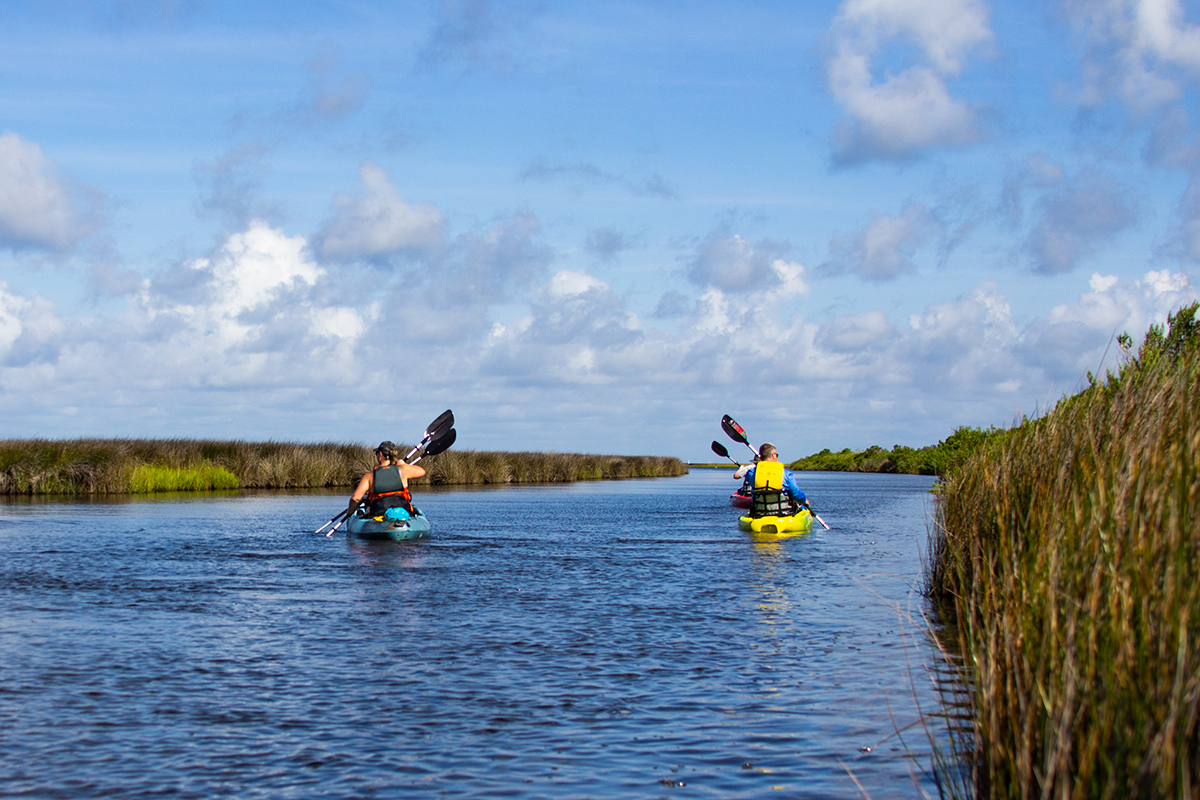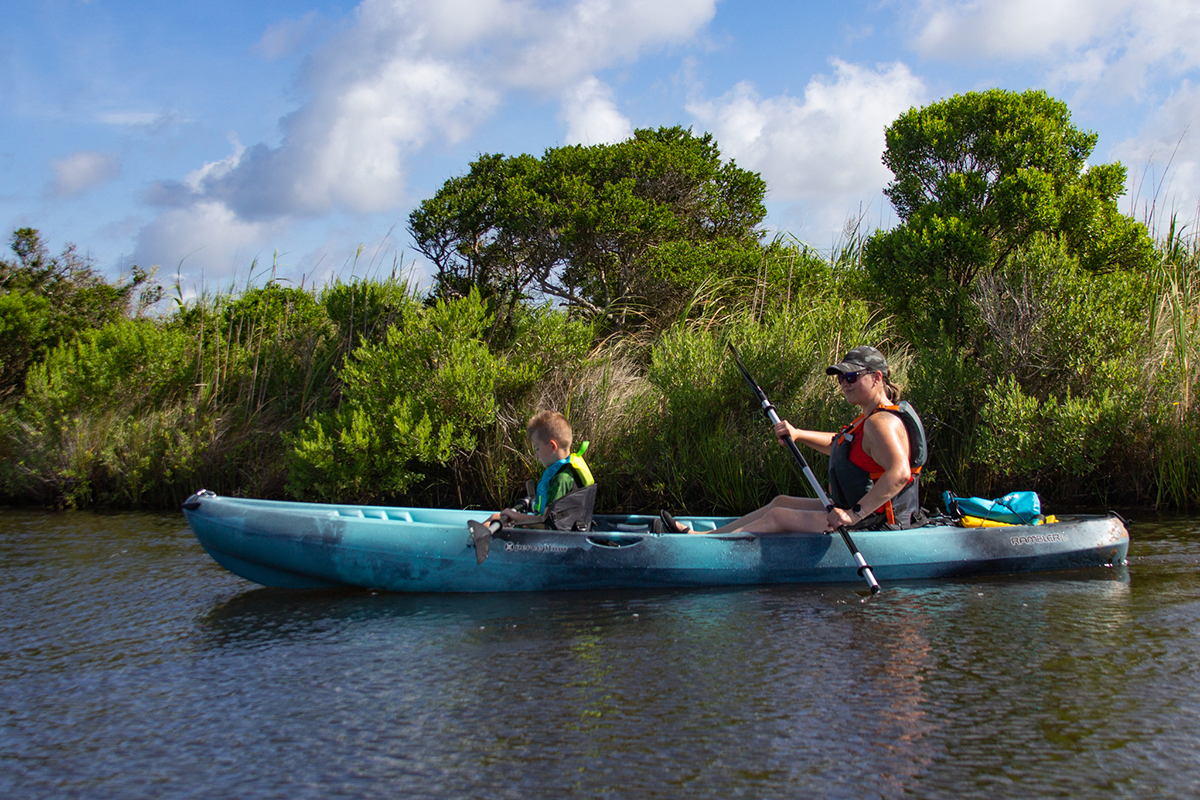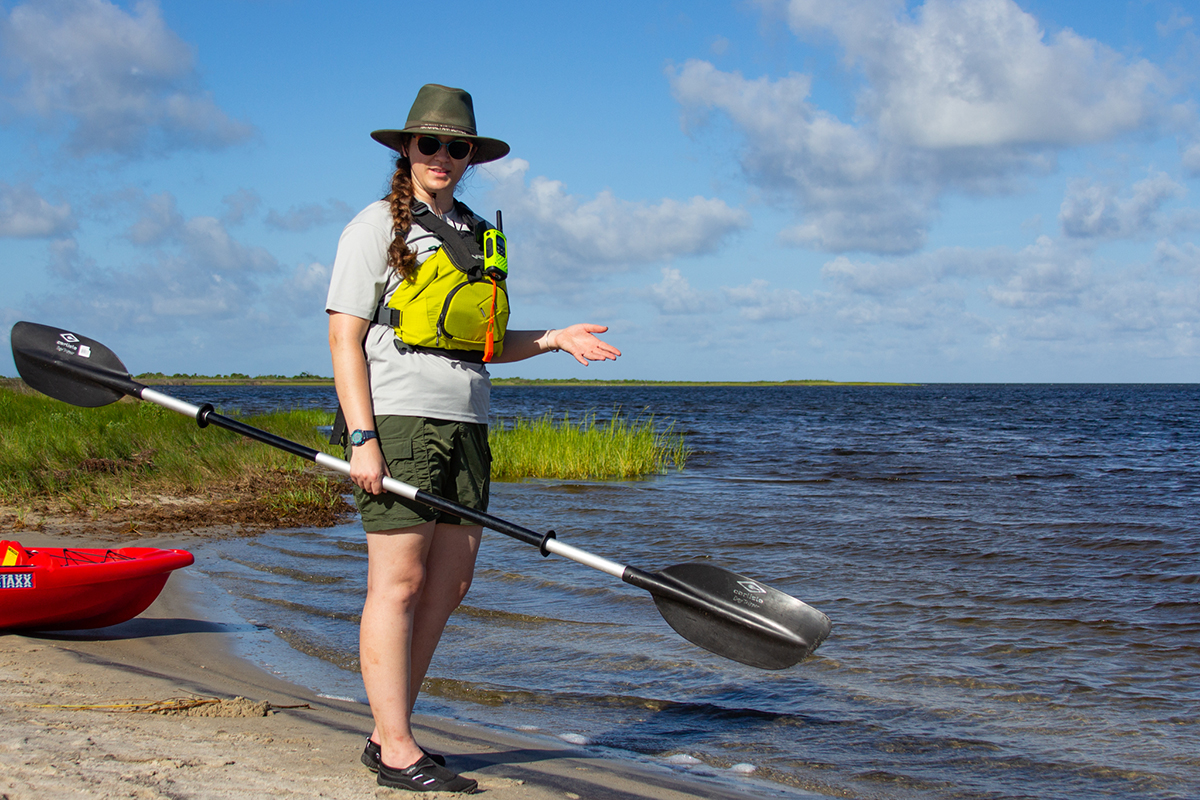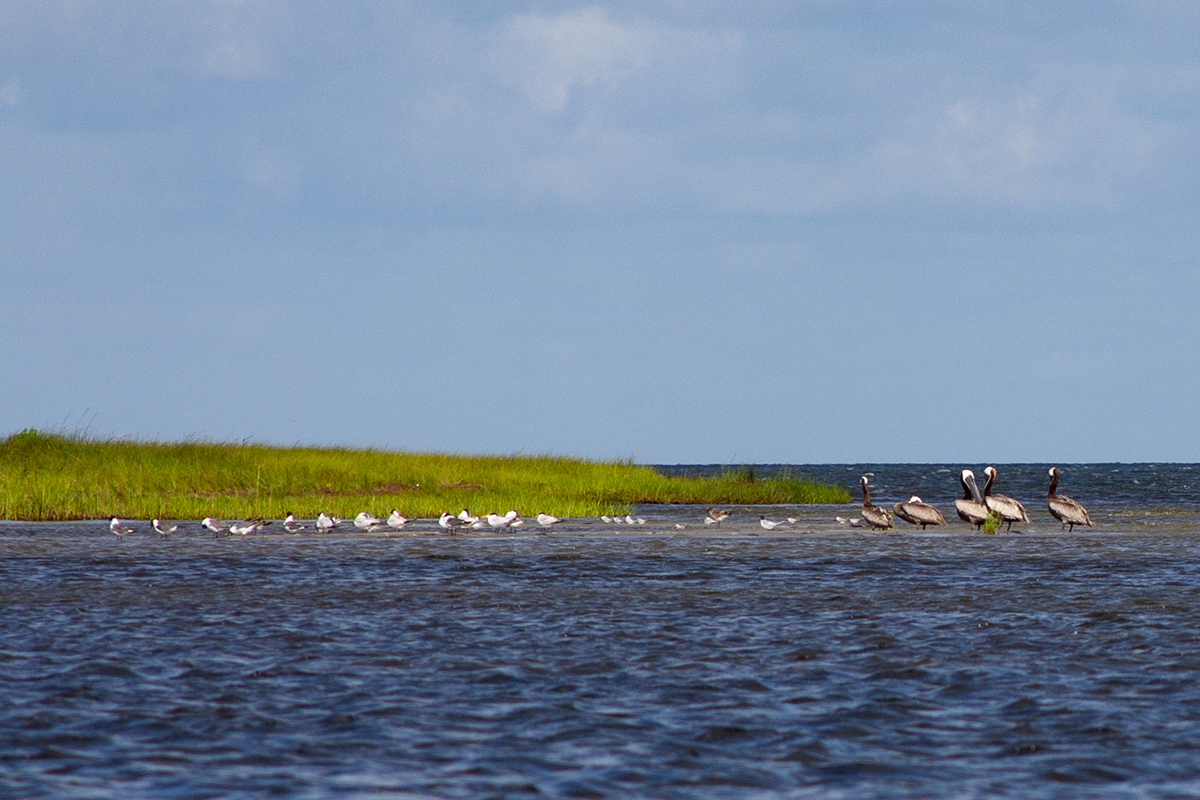
A dragonfly zipped over the water.
“Who knows why we love dragonflies?” queried Sarah Burgart, the National Park Service lead interpretation ranger for Hatteras Island.
Supporter Spotlight
For a moment, one could only hear the wind and the quiet dip of kayak paddles in Pamlico Sound, a large body of brackish water that separates the barrier islands of Hatteras and Ocracoke from their respective counties’ mainland portions of Dare and Hyde, just to the west.
“I don’t know; why?” responded Tara Augustin, as she paddled a double kayak with her 7-year-old son, Nicholas.
“Because they eat mosquitoes,” Burgart said.
“I didn’t know that,” Tara’s husband and Nicholas’ father, Randy Augustin, admitted Monday after the tour, the first in the Cape Hatteras National Seashore’s new “Kayak with a Ranger” program.
Education and sustainable enjoyment of the area are goals of the program, which is scheduled for 8:30 to 10:30 a.m. every Monday and Friday through Labor Day in Salvo.
Supporter Spotlight
The Augustins, vacationing from Maryland, participated in the first program offering Monday. The couple said they appreciated being guided by those with knowledge of the area and nature.
“We like to kayak,” Tara Augustin said. “We like to learn about the area. It’s better than us going around by ourselves, not knowing what we’re looking at.”
As it was, they saw many common sound residents during the tour: Laughing gulls wheeled overhead, a skate flashed briefly in the water and a startled blue heron flew upward out of the marsh grasses. Several pelicans shared a sandbar with a small flock of laughing gulls, all standing in the shallow water.
They also saw plenty of seagrass just underneath the water, which was never much more than a foot deep on the tour.
“The sound is a really good way to test the health of your environment because our seagrass is a little bit endangered and very important to the species that we have,” said Park Ranger Lauren Spier, who led the tour. “If we start to lose it, then we’re going to lose the opportunity for a lot of species to grow up.”

The sound serves as a nursery for many species, including blue crabs, shrimp and a variety of fish. The seagrass provides a place for them to hide from predators and from wind-driven currents.
The wind was blowing steadily at 11 mph, with gusts up to 16 mph, when the park rangers measured it before the program began.
Burgart said the cutoff to cancel a program would be winds of 15 mph or at the discretion of the instructors. Eight rangers are trained to lead the program, and after the first few weeks, two rangers will lead it. Originally from Iowa, Burgart most recently lived in Seattle, Washington, and was the third ranger on Monday, providing extra support to Spier and Chris Knoll, who brought up the rear on the tour.
“With the wind, a lot of smaller creatures were hunkered down,” Spier noted. “If you’re smaller, the wind will just take you. You can even feel that, just on the kayak.”
Originally from Texas, the 25-year-old has lived in five states and worked in several other national parks since graduating from college.

Spier began the tour with a brief caution about not swimming against rip currents in the ocean, advising to instead swim parallel to shore or make noise and wait for help or for the current to stop, since “they don’t go on forever.” Rip currents can move as quickly as 8 feet per second, faster than any Olympic swimmer, she noted. There are no rip currents in the sound.
Then she shared safety explanations, including a brief overview of how to kayak since all the participants had done it before, advising to just stand up if a kayak flips, since the water is shallow, and to blow the whistle attached to the life jacket if anyone needed help.
The tour started against the wind and was slow going until the kayaks reached the shelter of tall marsh grasses forming natural canals in the sound.
“This was just one small section of the sound,” Spier told participants afterward. “There are miles of coastline to explore.”
Cape Hatteras National Seashore was the first national seashore established in the country. It stretches over 70 miles on the southernmost end of the barrier islands known as the Outer Banks, including Dare County’s Bodie Island — South Nags Head — and Hatteras Island, as well as Hyde County’s Ocracoke Island. There are various public beach and sound accesses throughout.

“It was great,” Randy Augustin said of the tour. He enjoyed getting outdoors away from the crowds, and the “kayak with a comfortable seat” surpassed his expectations of typical rental equipment.
“We didn’t see as many osprey as I would have thought we would have seen today,” he noted. “There’s a ton of osprey where we’re at. Every once in a while, you’ll find a random fish in your yard (that an osprey drops).”
Tara Augustin said the family vacations regularly on the Outer Banks and saw the program announced on a few Facebook pages they follow to keep up with the area. That it was free with all gear provided and knowledgeable guides is what sparked their attention.
Knoll hosed off the kayaks after the tour. Originally from New Jersey and in his fourth season at Cape Hatteras, said that if participants are first-time area visitors, he hopes they’ll leave the program “with a better understanding of responsibly enjoying the area.” His hope for returning visitors or locals is that they’ll see “there’s always more to learn” about responsibly enjoying the area.
Burgart said the program encourages appreciation of all the ecosystems present around the national seashore: “They all exist in balance and are all important.”
Jonathan Polk, the national seashore’s supervisory park ranger, expressed a similar sentiment in an email response to Coastal Review.
“We are very excited about this new opportunity because kayaking is a popular recreational activity here at Cape Hatteras National Seashore and a great way to explore habitats such as salt marshes and the waters of the Pamlico Sound,” Polk said. “We wanted to provide the public with a new and engaging experience that would allow them to explore these habitats of their National Seashore that they may not have been able to fully experience in the past.”
Besides kayaking, Knoll also leads a surf fishing program and Spier also leads a “soundside explorers” program. Burgart said the rangers are able to provide a variety of interpretive programs to the public because the Cape Hatteras Lighthouse has been closed to climbing since 2020. The lighthouse was initially closed because of COVID-19 precautions, and then renovations were started in 2021.
Rangers from Bodie Island Lighthouse will be assisting with the kayaking program on Fridays. Salvo is “about halfway between” the two lighthouses, located slightly closer to Bodie, Burgart said.
Registration is required. Call 252-475-9622 after 9 a.m. the Saturday before the desired program date. Each program has 10 available spots. Children must be at least 7 to participate and at least 12 to paddle their own kayak.
Donations may be made to Outer Banks Forever, a nonprofit supporting the three national parks of the Outer Banks, at obxforever.org.







